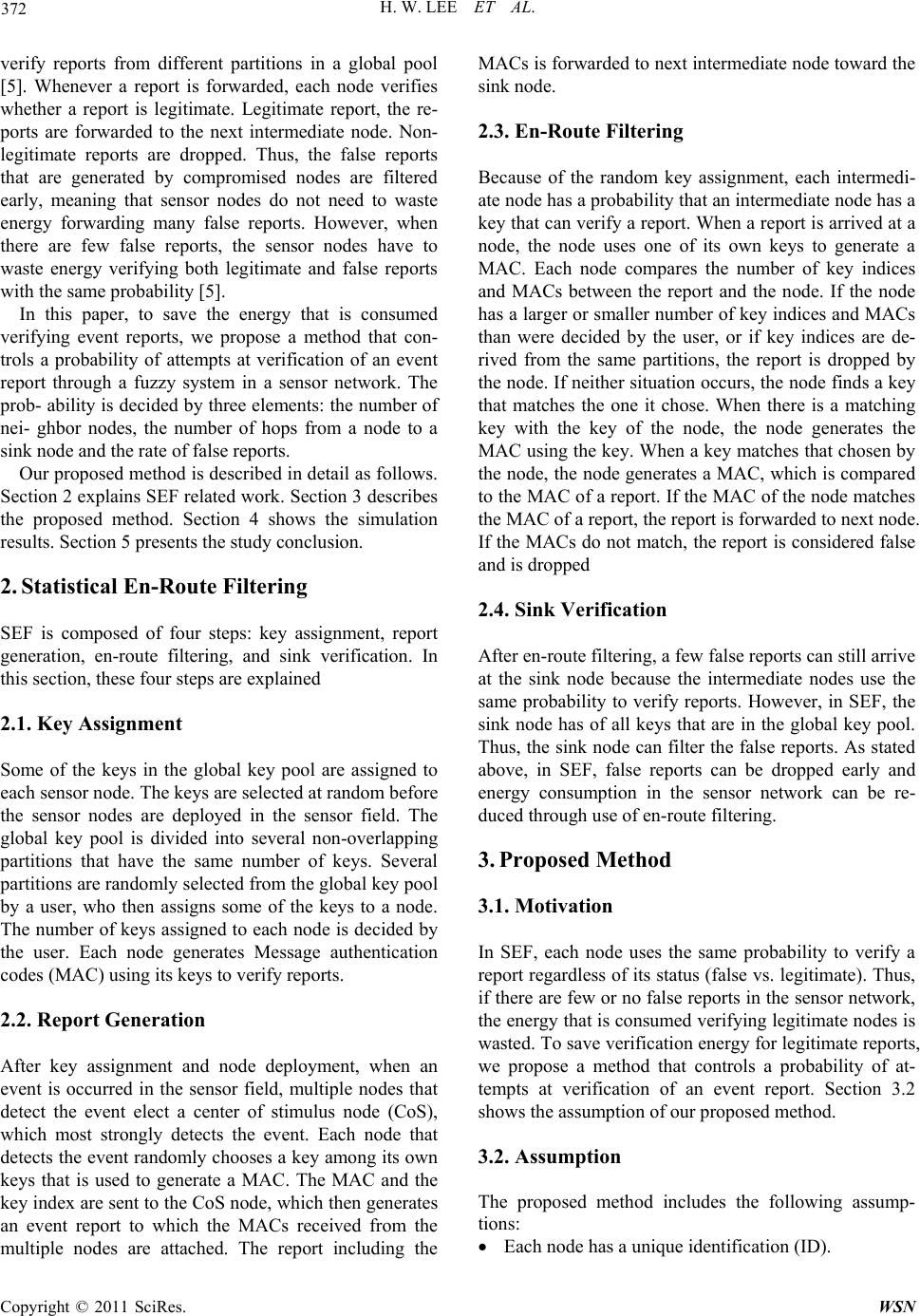
H. W. LEE ET AL.
372
verify reports from different partitions in a global pool
[5]. Whenever a report is forwarded, each node verifies
whether a report is legitimate. Legitimate report, the re-
ports are forwarded to the next intermediate node. Non-
legitimate reports are dropped. Thus, the false reports
that are generated by compromised nodes are filtered
early, meaning that sensor nodes do not need to waste
energy forwarding many false reports. However, when
there are few false reports, the sensor nodes have to
waste energy verifying both legitimate and false reports
with the same probability [5].
In this paper, to save the energy that is consumed
verifying event reports, we propose a method that con-
trols a probability of attempts at verification of an event
report through a fuzzy system in a sensor network. The
prob- ability is decided by three elements: the number of
nei- ghbor nodes, the number of hops from a node to a
sink node and the rate of false reports.
Our proposed method is described in detail as follows.
Section 2 explains SEF related work. Section 3 describes
the proposed method. Section 4 shows the simulation
results. Section 5 presents the study conclusion.
2. Statistical En-Route Filtering
SEF is composed of four steps: key assignment, report
generation, en-route filtering, and sink verification. In
this section, these four steps are explained
2.1. Key Assignment
Some of the keys in the global key pool are assigned to
each sensor node. The keys are selected at random before
the sensor nodes are deployed in the sensor field. The
global key pool is divided into several non-overlapping
partitions that have the same number of keys. Several
partitions are randomly selected from the global key pool
by a user, who then assigns some of the keys to a node.
The number of keys assigned to each node is decided by
the user. Each node generates Message authentication
codes (MAC) using its keys to verify reports.
2.2. Report Generation
After key assignment and node deployment, when an
event is occurred in the sensor field, multiple nodes that
detect the event elect a center of stimulus node (CoS),
which most strongly detects the event. Each node that
detects the event randomly chooses a key among its own
keys that is used to generate a MAC. The MAC and the
key index are sent to the CoS node, which then generates
an event report to which the MACs received from the
multiple nodes are attached. The report including the
MACs is forwarded to next intermediate node toward the
sink node.
2.3. En-Route Filtering
Because of the random key assignment, each intermedi-
ate node has a probability that an intermediate node has a
key that can verify a report. When a report is arrived at a
node, the node uses one of its own keys to generate a
MAC. Each node compares the number of key indices
and MACs between the report and the node. If the node
has a larger or smaller number of key indices and MACs
than were decided by the user, or if key indices are de-
rived from the same partitions, the report is dropped by
the node. If neither situation occurs, the node finds a key
that matches the one it chose. When there is a matching
key with the key of the node, the node generates the
MAC using the key. When a key matches that chosen by
the node, the node generates a MAC, which is compared
to the MAC of a report. If the MAC of the node matches
the MAC of a report, the report is forwarded to next node.
If the MACs do not match, the report is considered false
and is dropped
2.4. Sink Verification
After en-route filtering, a few false reports can still arrive
at the sink node because the intermediate nodes use the
same probability to verify reports. However, in SEF, the
sink node has of all keys that are in the global key pool.
Thus, the sink node can filter the false reports. As stated
above, in SEF, false reports can be dropped early and
energy consumption in the sensor network can be re-
duced through use of en-route filtering.
3. Proposed Method
3.1. Motivation
In SEF, each node uses the same probability to verify a
report regardless of its status (false vs. legitimate). Thus,
if there are few or no false reports in the sensor network,
the energy that is consumed verifying legitimate nodes is
wasted. To save verification energy for legitimate reports,
we propose a method that controls a probability of at-
tempts at verification of an event report. Section 3.2
shows the assumption of our proposed method.
3.2. Assumption
The proposed method includes the following assump-
tions:
Each node has a unique identification (ID).
Copyright © 2011 SciRes. WSN